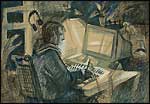With digital technology at the forefront of every camera that you will see in the market today, it is not surprising that alongside this trend is the increase in the number of graphic tools for computers.
Now, not only do photographers have the ability to adjust the look of the pictures that they take with their digital cameras, they also have the necessary tools that will help them add more effects and create a whole new picture from the photographs that they have taken.
Below are just some of the best graphic tools and software in the market that photographers, both amateur and professional, will sure love.
Adobe Photoshop
This is perhaps the most popular and most reliable software in the market. It is widely used not only in businesses and commercial establishments but also at home. This software is remarkably easy to use and very useful. Because of its wide range of functions, there are but a few that this software cannot do, if there are any! It is one of the most flexible tools available for photographers.
Among the features that make this a stand out is the layering masks, the adjustment layers, the history brush and the layering effects, which is highly useful especially when doing multiple adjustments. Users can also make adjustments or corrections without changing the original composition of the photograph. The most recent version is the Adobe CS, which will run both in Windows and Mac.
Wacom's Graphire3 Tablet
Because of its more ergonomic feel, this software is also a winner for digital graphic artists as well as photographers. Although, this is not as easy to use as the Adobe Photoshop, it is still comfortable to work with.
With this software, artists need not use the mouse to make adjustments. They will be using a special pen pointer which will come in handy especially when drawing a particular image or retouching a photo. This is very ideal for digital artists that deal mainly with retouching because the pointer will work best in these situations. Like Adobe, this software will also run on Windows and Mac.
Jasc Paint Shop Pro 9
Although it is often likened to the Photoshop, having basically the same range of functions, Graphic experts feel that it has a long way to go. Still, compared to its earlier versions, the Pro 9 is a definite winners, with its streamlined space and new tools and effects. Another really great feature is the option for personalization. This runs only in Windows.
In this transition phase of analog to digital photography, everyone knows the difference on how each images is processed into a nice print. For analog photography, the negative (film) is developed into photos in small shops called developing studios, low-end or high end, available some walks away from a nearby establishment.
They come in cheap price for every piece of shot but they come expensive in rolls. This is the conventional way of accomplishing photography. Nowadays there is digital camera mania everywhere! Who would not want private photograph shots from a handy dandy digital camera, where printing is done at home at one's convenience?
Convenience and privacy are the perfect words for digital photography. The question is how convenient is it to produce a copy? About privacy, there is no doubt, when you take a shot with a digital camera, it does not have to go out of the house.
All you need is a printer. When you need a printer, the array of other needs will start to fall in line one by one because it takes the following to create you own printing of digital photography. For a good digital photography printing, you will the following:
a. A high-resolution digital camera with at least 2 mega-pixel resolution
b. A stand-alone digital printer (no need for a computer)
c. Fully loaded personal computer
It goes to show, processing digital printing at home is not cheap. The mania is only applicable to those who have PCs at home. Let's say you have all the equipments for digital photography printing, the next requirements are quite complex than it seems.
Digital cameras are capable of deleting undesirable shots at once. There is no more worry for wasted film for bad shots. Now it is time to transfer or load your images to your PC.
At a subdirectory you will see the photos transferred into digital files commonly in JPEG or RAW format. In the future, this will change. The setting and configuration of your digital camera will greatly affect the output you expect.
The very important aspect to be understood when doing digital photography printing is having knowledge about RESOLUTION. What you see in the computer monitor is not what you will see in the printer. This is overwhelming for beginners. Dot representation or pixels comprise an image.
At minimal requirement, a setting of 300 dpi (dots per inch) will already make a good print. For better prints, resolution must be higher. Expect the computer to slow down, assign a realistic values.
Article Source: http://www.SubmitYourNewArticle.com
Low Jeremy maintains Digital-Photography.ArticlesForReprint.com. This content is provided by Low Jeremy. It may be used only in its entirety with all links included.

Thursday, March 22, 2007
Must Have Computer Equipment And For Any Photographer
Posted by
Valery
at
7:36 PM
0
comments
![]()
Subscribe to:
Comments (Atom)


